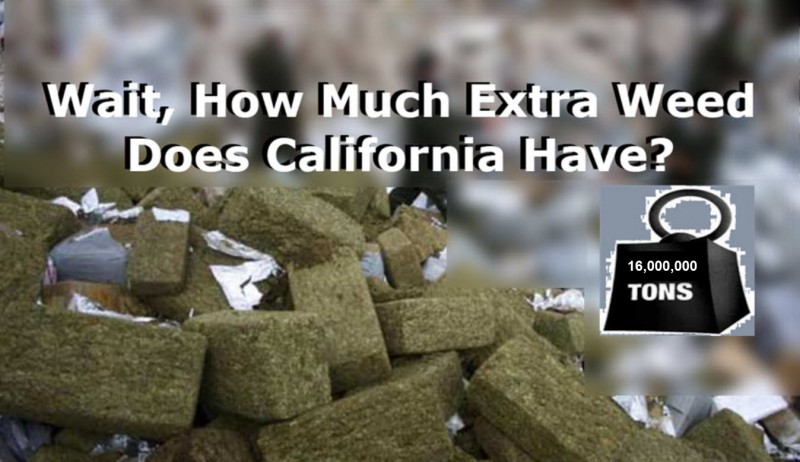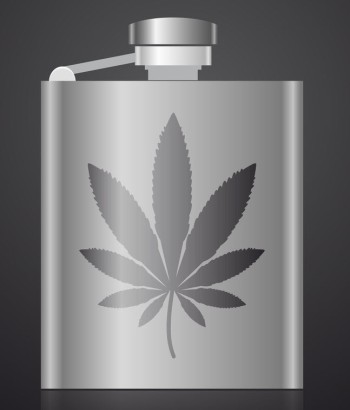So, exactly how big is The Great California Weed Surplus? It's really, really big.
How much weed is too much weed? How about 16 million tons? Let me say that again: 16 million TONS. That's how much weed experts are predicting will be grown in Cali over the next 12 months. That's nothing short of colossal. Problem is, that's 14 million more tons than the state can consume, according to current estimates. What are they going to do with all that extra weed?
There was already a "Green Rush" going on on the West Coast before California legalized adult recreational marijuana last November. (New laws take effect in January of 2018.) Since then, already-in-business growers have been gearing up to meet the added demand. Meanwhile, newcomers are eyeing the market with green eyes and building out grows at an exponential rate. It's starting to look a lot like the Gold Rush - too many miners, many of which may fail miserably.
That's a mountain of herb
So what does 16 million tons of ganja look like? Let's put this in perspective:
-
A pound is about enough to fill an average cereal box. There are 2,000 pounds in a ton. That a total of 32 BILLION - with a 'B' - pounds
.
That's about ten times the number of boxes of cereal sold in a year.
-
Ancient Egyptian megastructure, The Great Pyramid of Giza, weighs around 6 million tons - about a third the weight of a 16 million ton pile of weed.
And weed is a tenth of the weight of granite blocks. So a mountain of weed would be like 30 times bigger.

So, who says 32 billion pounds is too much?
Hezekiah Allen does. And he's no slouch. He's Executive Director of the California Growers’ Association, the state's NGO authority on the subject or growing marijuana. Speaking at a panel hosted by the Sacramento Press Club, Allen told attendees that he estimates growers in the Golden State are producing eight times as much cannabis as the state is expected to consume - about 14 to 16 million tons annually. But buyers are unlikely to consume more than two million tons over the next year.
Another expert on the topic, Joseph Devlin, Chief of Cannabis Policy and Enforcement for the City of Sacramento, puts the figure at five times as much cannabis as the state is expected to consume - still way too much. On the other end of the spectrum, an anonymous grower in attendance claimed that the surplus will be much higher than either Allen's or Devlin's estimates.
Growing the Black Market
California growers now have to seriously consider how they are going to cope with the projected surplus. According to Allen, when revised cannabis laws take effect in January of 2018, much of the surplus could end up being sold on the black market.
The way things stand, when the product leaves the farm, the farmer might have no idea where it's going to end up being processed or sold. Come January, 2018, all compliant license holders are going to have to account for every single gram that leaves their property.
Chief of Cannabis Policy and Enforcement for the City of Sacramento, Lori Ajax is warning growers they will have to scale back if they aim to remain in compliance, but predicts that many growers will opt to sell on the black market in other states. “For right now, our goal is to get folks into the regulated market, as many as possible,” Ajax said. But, she added, “There are some people who will never come into the regulated market.”
Oaksterdam University professor Dr. Aseem Sappal is optimistic. He believes most serious growers want to be compliant and will do what it takes. “Nobody wants to operate under the radar. They want to do this legally," Sappel said in an interview with local CBS news. "They want to say, ‘Hey, look, what I’m doing is okay.'”
To Sappal's chagrin, many local governments are banning weed sales or drastically restricting the number and location of retail outlets, giving growers little incentive to work toward compliance, and plenty of reason to resort to selling on the black market. Such a large black market would have serious consequences for law enforcement. It is also likely to incur severe environmental costs, as illicit growers tend to use chemical fertilizers and pesticides that compliant growers are not allowed to use.

So, what to do with all that weed?
States such as Nevada and Washington have the opposite problem: a shortage. I'm sure they'd be happy to have some of California's surplus sent their way. Unfortunately, unlike wine, cannabis growers can't legally export their products across state lines because the Federal government is still being, well, the government. So what is California going to do with over 10 million tons of surplus bud?
How about putting it into dabs, edibles and vape juice? Sappal has proposed extraction on a massive scale as a potential solution. “About 75 pounds of cannabis — which is a lot — can produce perhaps, what, five liters of oil,” said Sappal. “And if you look at that, then a lot of cannabis can make a little oil. So if you talk about a surplus, that’s one very good avenue.”
But not so fast. Mass extraction technology can cost as much as a quarter of a million dollars or more per installation. Then there's the overhead costs of running it - supplies, repairs, operators, packaging, and so on. All told, it could add as much as $5 per gram to the cost of processing the bud. And it takes at least 10 grams of flowers to make a 1 gram dab. (I know, that would be a huge - and expensive - dab, right.)
Extraction would definitely reduce the volume of product, but it wouldn't reduce the amount of THC by much. For this plan to succeed, 420-friendly Californians and tourists in the Golden State would still have to consume 8 times as much THC than the current anticipated demand. Can you imagine Californians being 8 times higher than they are now?
Hezekiah Allen's suggestion is that state and local governments to do more licensing and less banning. He figures, the more retailers, and the more places people are allowed to consume, the more cannabis gets sold. That leaves CA in the same pickle as above - a far more stoned population - good for the economy, but bad for employers.
How about stashing some for later? That won't work either. Storage concerns and costs aside, growers would have to shut down their operations for the next seven years, until the supply is back in line with demand. Of course it wouldn't work exactly like that, but it gives you another picture of just how overstocked growers might be if they meet projected production capacity.
So far, no one has come forth with a realistic solution to the gargantuan problem. If you would like to be part of the solution, consider scheduling your 2018 vacation in California. I suspect that ganja prices in the Golden State will be quite reasonable by then.
OTHER STORIES YOU MAY ENJOY...
TAX FREE WEED IN CALIFORNIA, READ UP, CLICK HERE.
OR..
CALIFORNIA PROTECTS CANNABIS GROWERS, CLICK HERE.








